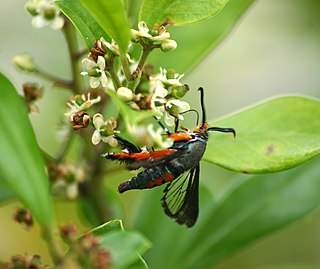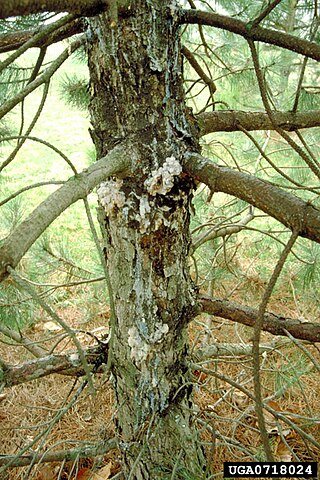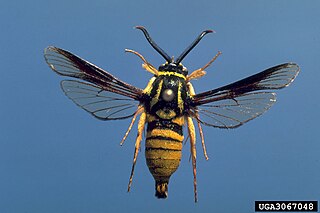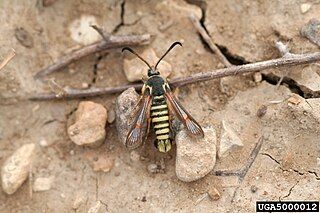
The Sesiidae or clearwing moths are a diurnal moth family in the order Lepidoptera known for their Batesian mimicry in both appearance and behaviour of various Hymenoptera.

The squash vine borer is a diurnal species of sesiid moth. The moth is often mistaken for a bee or wasp because of its movements, and the bright orange hind leg scales. The females typically lay their eggs at the base of leaf stalks, and the caterpillars develop and feed inside the stalk, eventually killing the leaf. They soon migrate to the main stem, and with enough feeding damage to the stem, the entire plant may die. For this reason, it is considered a pest that attacks cultivated varieties of squash, zucchini, pumpkin, and acorn squash. The squash vine borer is native to North America, with some reports as far south as Brazil and Argentina. It lives in most temperate North American states, except the Pacific coast. Southern states have two broods a year.

The hornet moth or hornet clearwing is a large moth native to Europe and the Middle East and has been introduced to North America. Its protective coloration is an example of Batesian mimicry, as its similarity to a hornet makes it unappealing to predators. The hornet moth has been linked to the large dieback of poplar trees across Europe because its larvae bore into the trunk of the tree before re-emerging as adults.

Sesia bembeciformis, the lunar hornet moth, is a moth of the family Sesiidae. It is found in Europe.
Ichneumenoptera chrysophanes, the clearwing persimmon borer, is a moth of the family Sesiidae. It is found from Cairns in Queensland to Canberra in the Australian Capital Territory.

Sesia is a genus of moths in the family Sesiidae.

Podosesia is a genus of moths in the family Sesiidae. It was originally named Grotea in 1876 but this name was replaced in 1879

Synanthedon pictipes, the lesser peachtree borer, is a moth of the family Sesiidae. It is known from the eastern half of Canada and the United States westward to Minnesota in the north and eastern Texas in the south.

Synanthedon pini, the pitch mass borer, is a moth of the family Sesiidae. The pitch mass borer occurs on spruce and pine in eastern North America. It does not kill trees, but the pitch-filled larval tunnels in the wood cause defects in the lumber.

Paranthrene simulans, the red oak clearwing borer, hornet clearwing or oak clearwing borer, is a moth of the family Sesiidae. It is found in eastern North America, from Nova Scotia to Florida, west to Minnesota, Missouri and Mississippi.

Synanthedon rileyana, the horsenettle borer or Riley's clearwing moth, is a moth of the family Sesiidae. It is found in the United States, including Arkansas, Arizona, Missouri, Oklahoma, North Carolina and Pennsylvania.

Chamaesphecia crassicornis is a moth of the family Sesiidae. It is found in south-eastern Austria, southern Slovakia, Hungary, Serbia, Romania, Bulgaria, southern Russia, Kazakhstan and Kyrgyzstan. It is rare in central Europe. It has been released in North America for the biological control of leafy spurge.

Carmenta mimuli, the coronopus borer, is a moth of the family Sesiidae. The dark form is the typical form and is found in Arizona. The whitish form is non-typical and is known from the south-western United States, from Kansas to Arizona.

Melittia gloriosa, the glorious squash vine borer or manroot borer, is a moth of the family Sesiidae. It is known from North America, including Arizona, California, New Mexico, Oklahoma and Texas.

Sannina uroceriformis, the persimmon borer, is a moth of the family Sesiidae. It is found along the Atlantic coast of the United States, from New Jersey to Florida and westward to Texas, Oklahoma, Missouri, Kansas, Ohio and Indiana.
Synanthedon beutenmuelleri is a moth of the family Sesiidae. It is known from the Republic of the Congo.
Synanthedon leucogaster is a moth of the family Sesiidae. It is known from Gabon.















